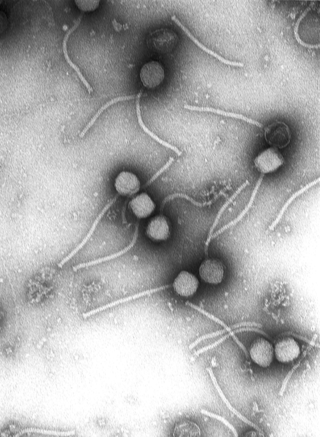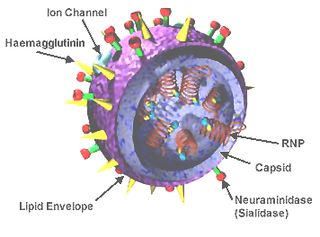
Virology is the scientific study of biological viruses. It is a subfield of microbiology that focuses on their detection, structure, classification and evolution, their methods of infection and exploitation of host cells for reproduction, their interaction with host organism physiology and immunity, the diseases they cause, the techniques to isolate and culture them, and their use in research and therapy.

Reverse transcription polymerase chain reaction (RT-PCR) is a laboratory technique combining reverse transcription of RNA into DNA and amplification of specific DNA targets using polymerase chain reaction (PCR). It is primarily used to measure the amount of a specific RNA. This is achieved by monitoring the amplification reaction using fluorescence, a technique called real-time PCR or quantitative PCR (qPCR). Confusion can arise because some authors use the acronym RT-PCR to denote real-time PCR. In this article, RT-PCR will denote Reverse Transcription PCR. Combined RT-PCR and qPCR are routinely used for analysis of gene expression and quantification of viral RNA in research and clinical settings.

Influenza A virus (IAV) is a pathogen that causes the flu in birds and some mammals, including humans. It is an RNA virus whose subtypes have been isolated from wild birds. Occasionally, it is transmitted from wild to domestic birds, and this may cause severe disease, outbreaks, or human influenza pandemics.

Influenza hemagglutinin (HA) or haemagglutinin[p] is a homotrimeric glycoprotein found on the surface of influenza viruses and is integral to its infectivity.

Orthomyxoviridae is a family of negative-sense RNA viruses. It includes seven genera: Alphainfluenzavirus, Betainfluenzavirus, Gammainfluenzavirus, Deltainfluenzavirus, Isavirus, Thogotovirus, and Quaranjavirus. The first four genera contain viruses that cause influenza in birds and mammals, including humans. Isaviruses infect salmon; the thogotoviruses are arboviruses, infecting vertebrates and invertebrates. The Quaranjaviruses are also arboviruses, infecting vertebrates (birds) and invertebrates (arthropods).

Influenza C virus is the only species in the genus Gammainfluenzavirus, in the virus family Orthomyxoviridae, which like other influenza viruses, causes influenza.

H6N2 is an avian influenza virus with two forms: one has a low and the other a high pathogenicity. It can cause a serious problem for poultry, and also infects ducks as well. H6N2 subtype is considered to be a non-pathogenic chicken virus, the host still unknown, but could strain from feral animals, and/or aquatic bird reservoirs. H6N2 along with H6N6 are viruses that are found to replicate in mice without preadaptation, and some have acquired the ability to bind to human-like receptors. Genetic markers for H6N2 include 22-amino acid stalk deletion in neuraminidase (NA) protein gene, increased N-glycosylation, and a D144 mutation of the Haemagglutinin (HA) protein gene. Transmission of avian influenza viruses from wild aquatic birds to domestic birds usually cause subclinical infections, and occasionally, respiratory disease and drops in egg production. Some histological features presented in chicken infected with H6N2 are fibrinous yolk peritonitis, salpingitis, oophoritis, nephritis, along with swollen kidneys as well.

H5N1 genetic structure is the molecular structure of the H5N1 virus's RNA.
In the diagnostic laboratory, virus infections can be confirmed by a myriad of methods. Diagnostic virology has changed rapidly due to the advent of molecular techniques and increased clinical sensitivity of serological assays.

Influenza, commonly known as "the flu" or just "flu", is an infectious disease caused by influenza viruses. Symptoms range from mild to severe and often include fever, runny nose, sore throat, muscle pain, headache, coughing, and fatigue. These symptoms begin from one to four days after exposure to the virus and last for about 2–8 days. Diarrhea and vomiting can occur, particularly in children. Influenza may progress to pneumonia, which can be caused by the virus or by a subsequent bacterial infection. Other complications of infection include acute respiratory distress syndrome, meningitis, encephalitis, and worsening of pre-existing health problems such as asthma and cardiovascular disease.

In molecular biology, hemagglutinins are receptor-binding membrane fusion glycoproteins produced by viruses in the Paramyxoviridae and Orthomyxoviridae families. Hemagglutinins are responsible for binding to receptors on red blood cells to initiate viral attachment and infection. The agglutination of red cells occurs when antibodies on one cell bind to those on others, causing amorphous aggregates of clumped cells.
Virus quantification is counting or calculating the number of virus particles (virions) in a sample to determine the virus concentration. It is used in both research and development (R&D) in academic and commercial laboratories as well as in production situations where the quantity of virus at various steps is an important variable that must be monitored. For example, the production of virus-based vaccines, recombinant proteins using viral vectors, and viral antigens all require virus quantification to continually monitor and/or modify the process in order to optimize product quality and production yields and to respond to ever changing demands and applications. Other examples of specific instances where viruses need to be quantified include clone screening, multiplicity of infection (MOI) optimization, and adaptation of methods to cell culture.
The FluChip is a low-density DNA microarray for the identification of influenza viruses, originally developed at the University of Colorado at Boulder in the laboratory of Professor Kathy Rowlen in collaboration with the Centers for Disease Control and Prevention (CDC) in Atlanta.

George Keble Hirst, M.D. was an American virologist and science administrator who was among the first to study the molecular biology and genetics of animal viruses, especially influenza virus. He directed the Public Health Research Institute in New York City (1956–1981), and was also the founding editor-in-chief of Virology, the first English-language journal to focus on viruses. He is particularly known for inventing the hemagglutination assay, a simple method for quantifying viruses, and adapting it into the hemagglutination inhibition assay, which measures virus-specific antibodies in serum. He was the first to discover that viruses can contain enzymes, and the first to propose that virus genomes can consist of discontinuous segments. The New York Times described him as "a pioneer in molecular virology."
The National Centre for Foreign Animal Disease (NCFAD), located in the Canadian Science Centre for Human and Animal Health in Winnipeg, Manitoba, is part of the Canadian Food Inspection Agency’s National Centres for Animal Disease. NCFAD is co-located with the Public Health Agency of Canada’s National Microbiology Laboratory.
Chen Hualan is a Chinese veterinary virologist best known for researching animal epidemic diseases. She is a member of the World Organisation for Animal Health (OIE) and a member of the Food and Agriculture Organization Corporate Statistical Database (FAOSTAT). She is now a researcher and PhD Supervisor at Harbin Veterinary Research Institute of Chinese Academy of Agricultural Sciences.

Ilaria Capua is an Italian virologist and former politician, best known for her research on influenza viruses, particularly avian influenza, and her efforts promoting open access to genetic information on emerging viruses as part of pre-pandemic preparedness efforts.

Influenza D virus is a species in the virus genus Deltainfluenzavirus, in the family Orthomyxoviridae, that causes influenza.
Maria Caterina Zambon FMedSci FRCPath, is a British virologist, director of reference microbiology for Public Health England and a professor. Her main research areas include influenza vaccination and influenza hemagglutination inhibition.
The National Avian Influenza Reference Laboratory (NAIRL) is a BSL3 facility in Harbin, China.













